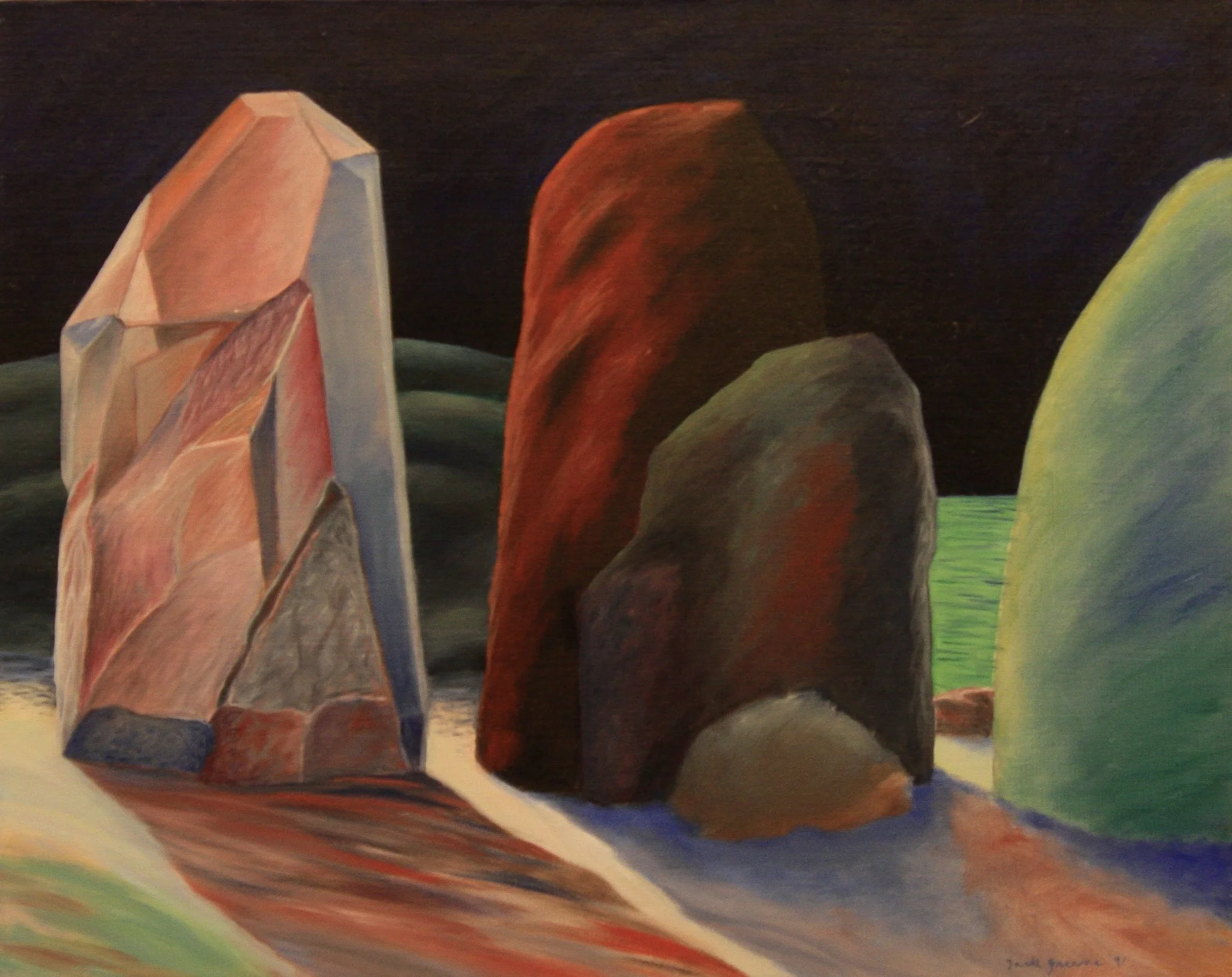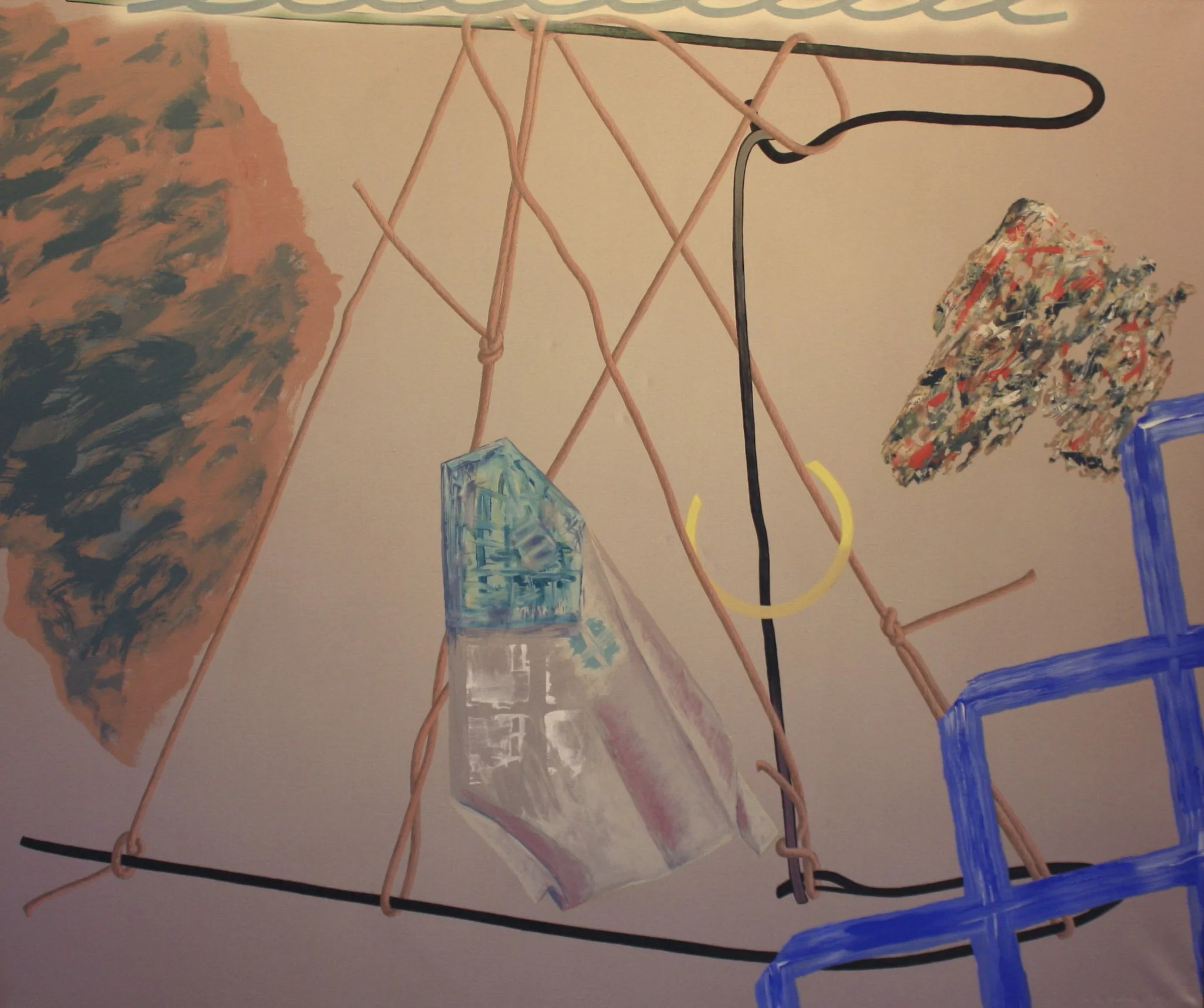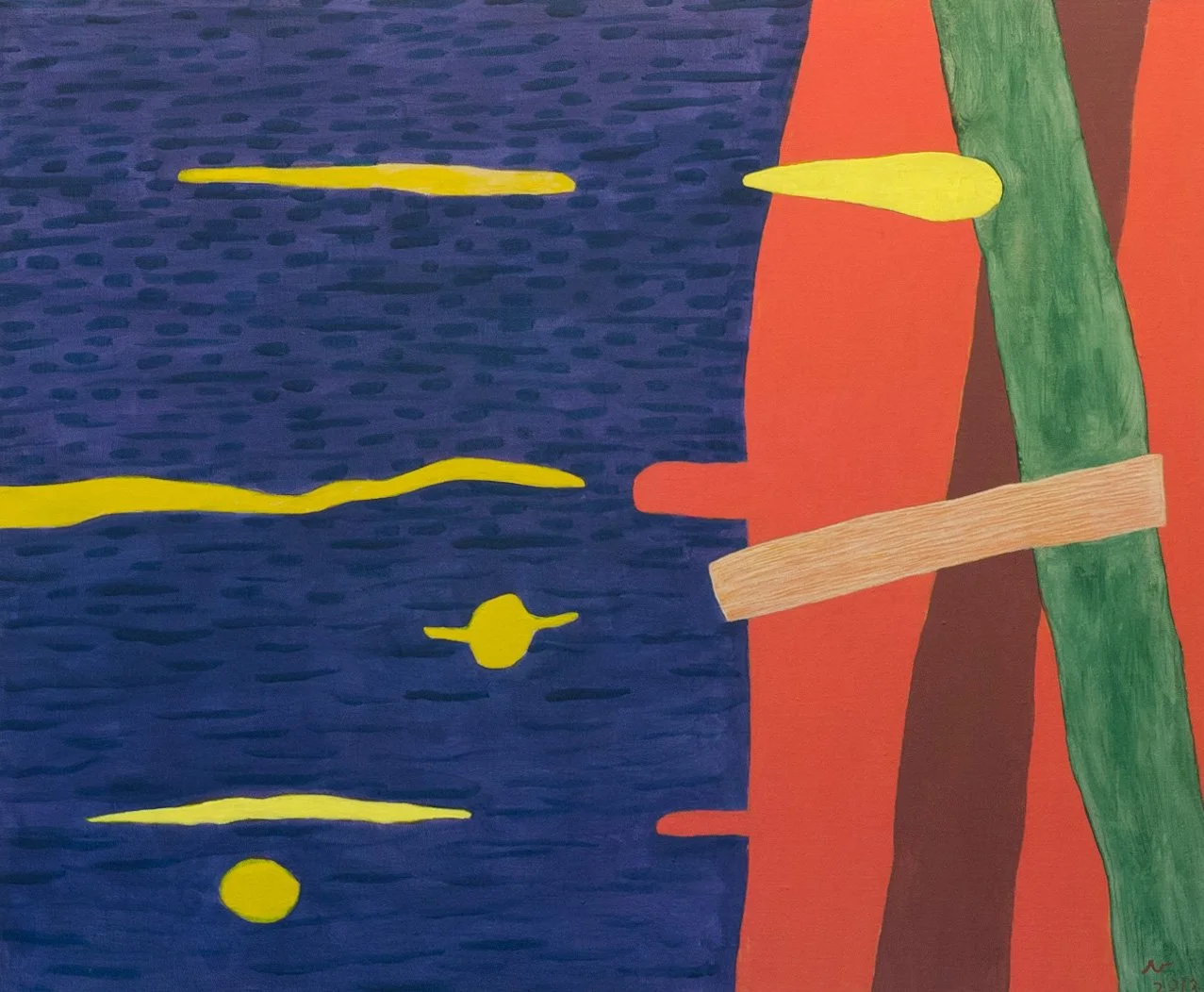On Jack Greene and his work.
Aqua, 1972, oil on linen, 24 x 96 inches
I’m on the phone with Jack. He’s got a wild turkey with a wounded foot that hobbles through his yard every day. It's a concern. Jack doesn’t want to miss the turkey's arrival because he gives her extra food. The walking thoroughfare that is the flock's ritual passes the bird feeder, the excited squirrels, and on down through the neighbor's yard below. Later, as is his habit, Jack will go over to his studio and listen to his vast record collection that dates back to the thirties, and includes Red Garland, Camarón de la Isla, Stéphane Grappelli, Django Reinhardt, an array of Raga music, Gnawa, Eric Dolphy, Paco Delucia, Ella Fitzgerald, The Sun Ra Arkestra, Bill Evans, Jimi Hendrix, John Coltrane, Portuguese Fada, just to name a few genres and artists This is what matters most to Jack now. Here and now. Sounds.
Visionary's Moment, 1977, Acrylic on linen, 50" x 60"
But the mainstay of Jack’s life-long enduring and dedicated activity, is that of art-making. Down the walkway from the simple Acorn style house where he lives with his partner and wife of 60 years, Marianne Carlet Greene, is the studio that he built about 80 percent himself. He poured the pilings, framed it out, built the cabinetry, scaled the drawers for art supplies, for his record collection, further detailed for cds and cassettes and custom designed almost every aspect of the space including the curved window sashes. Upon entering his studio, you immediately find six decades of work, stacked in racks, all catalogued, with hundreds of drawings in flat files. Massive oil on linen paintings produced in the late 60s and early seventies jut out into the space. Rolling carts of paintbrushes, paints, jars, molds, and clay works ready for mold making into aqua resin forms are ready for action. Jack, a master airbrush artist who later gravitated towards 3-D works (clay, cast with aqua resin and painted) for an extended period and then back to painting again. His last paintings take on a freedom that is fresh and unselfconscious. Not that his previous work wasn’t.
Palaces of Impermanence 1973, Oil on linen, 60 x 60 inches
It’s hard to describe the sheer scope of Jack’s creative output over the decades. Not only is it important work, but it has, for the most part, gone unseen and unappreciated by a wider audience. Jack is barely known except for what's most recently been shown with Peat and Repeat, including the exhibition at the Tashmoo Springs Pumping Station in Vineyard Haven, in 2021. In the nineties, he had exhibitions in New Mexico, and in the aughts, exhibitions on Martha’s Vineyard (where he lives) and earlier as part of Art in Embassies in Peru. His work was included in the San Francisco Museum of Art’s Rental Gallery but written up only a handful of times. And yet, the work is rigorous and stunning. He's never stopped. He never stopped considering the ways in which he could explore materials and interpret natural phenomena and the natural world within the context of his processes. However, in a world that relies upon networking and connecting, being exceedingly shy is not your helpmate. And that’s how it is.
To the Water, 1988, watercolor, 14 x 18 inches
After attending the Boston Museum School in the early sixties, and awarded a year-long scholarship for travel and research in Greece, Greene went to live in San Francisco. It was there that he met, Marianne. For many years, Jack made his living as a member of the Painters’ Union. Unafraid of heights, he was often sent out to paint some of the city’s most dangerous buildings including the famous Sutro Tower in Clarendon Heights where it still stands between the Twin Peaks. During that period, he successfully won and completed several public art murals and private commissions. For more than a decade, he kept a storefront studio in a building that he and Marianne managed in Haight Ashbury.
Oakland (CA) mural project. 1980/81.
Having lived in the Bay area for 25 years, he and Marianne headed to New Mexico in the nineties. They both loved the high desert mountains of the Southwest and were ardent hikers and campers — sometimes going out into the wilderness for weeks at a time. Much of Jack’s work of the period is informed by the natural world and those landscapes.
Crystal 1991, Oil on linen
To say that Jack has pursued the inner life though his work is an understatement. His earliest large-scale oil on linen airbrush works from the 1970s not only address the etheric iconography of geometric patterns and spatial considerations but with titles like Palaces of Impermanence exemplify his Buddhist leanings. These works, many as long as 18 feet have an almost prescient aspect where digital meets analogue, taking the viewer through inter-zonal channels.
Venetian Sequence, 1972, 19 x 108 inches, oil on linen
From this lean, and perhaps more austere landscape, his work exploded in another direction in the early eighties, morphing into a sea of strangely lit paintings with variegated and undulating forms and textures. Many paintings were inspired from his photographs and expanded upon to create other worlds that included highly detailed representational elements of chairs, ropes and shells. Still, the connections between these sometimes decades long series is in evidence by a seemingly invisible language that is possibly recognizable by the primordial brain.
Crux of the Matter, 1985, acrylic on linen, 50 x 60 inches,
In the early nineties, after having a dream of a multitude of tiny television screens, he introduced his early relief pieces that started as highly intricate and layered compositions. The details are fine. and betray an air of extraterrestrial landscapes; you can almost hear the sound from the UHF channel buzzing through snow and wood. Those works later evolved into large free floating pieces of which the highly technical aspect of their production could often take up to six months to complete.
Red Rain 1995, acrylic, molding paste, wood on linen, 12 x 14 inches
Drift 1991, acrylic on paper, 22.5 x 30 inches
Space Toon, 2013 Acrylic on linen, 28 x 34 inches
In a sense what an artist does is create puzzles and then solve them. To this end, one could say this is the essence of Jack’s work. It is internal-non-verbal work that speaks its own language not of the mental machinations or justifications but simply as an example of the one person’s high attention to detail and the sensorial conundrums that surround all of us. It’s not saying, “I’m saying this about that” rather it is a positioning of an exploratory nature. It’s a laying out of a mythic visual description of one person’s investigations.
Bird’s Eye, 1997, Aqua Resin and paint
This is but a brief introduction to Jack’s work. I think it speaks for itself. It is my hope, and those who know and deeply appreciate his work that one day he will have the representation and the appreciation that his oeuvre deserves. Now at 83 plus, it would be good to have that appreciation come sooner rather than later.
Caterina Verde
End of Summer, August 2024
Spray drawing 1970
On Pause, 2018, acrylic on linen, 30 x 26 inches
Jack from the back.
Studio, Vineyard Haven
Bodie Cross. Photograph from the west.
You can see more of Jack’s work on his Instagram page, his website or on Peat and Repeat.
UPCOMING: Essays and Interviews
Part II of Interview with Elke Luyten.
Interview with Anna Sang Park
Interview with Coder/Herbologist/Film Ace, Artist and Poet, Meredith Finkelstein
Essay on the work of Francine Hunter McGivern by Carter Ratcliffe
A look at Keith Donovan’s studio in Montmorillon, France
Interview with Daniel Rothbart, whose exhibition at Galerie Depardieu opens in September
PEAT and REPEAT BOOK SERIES:
Peat and Repeat is excited to announce that we are creating an artist book series that will include programming and workshop endeavors. We are launching a fundraising initiative for this series. More on this soon.
We really do rely on tax-deductible donations to keep going! The more we can fundraise the more projects in the community we can produce and our intention is to expand our community outreach.
















